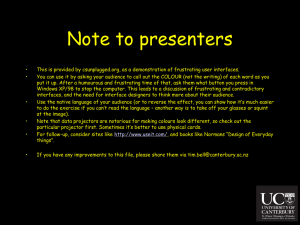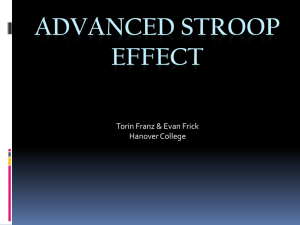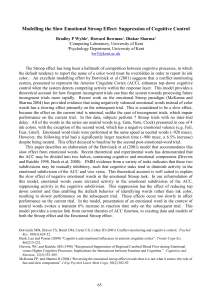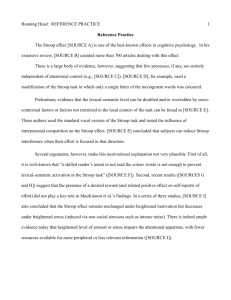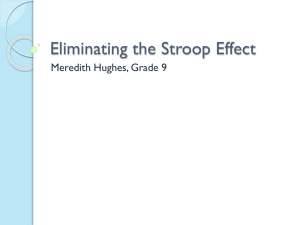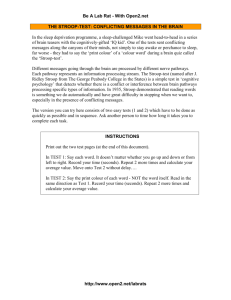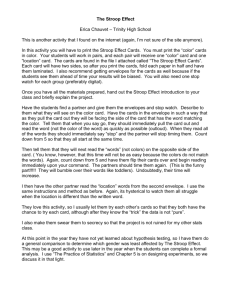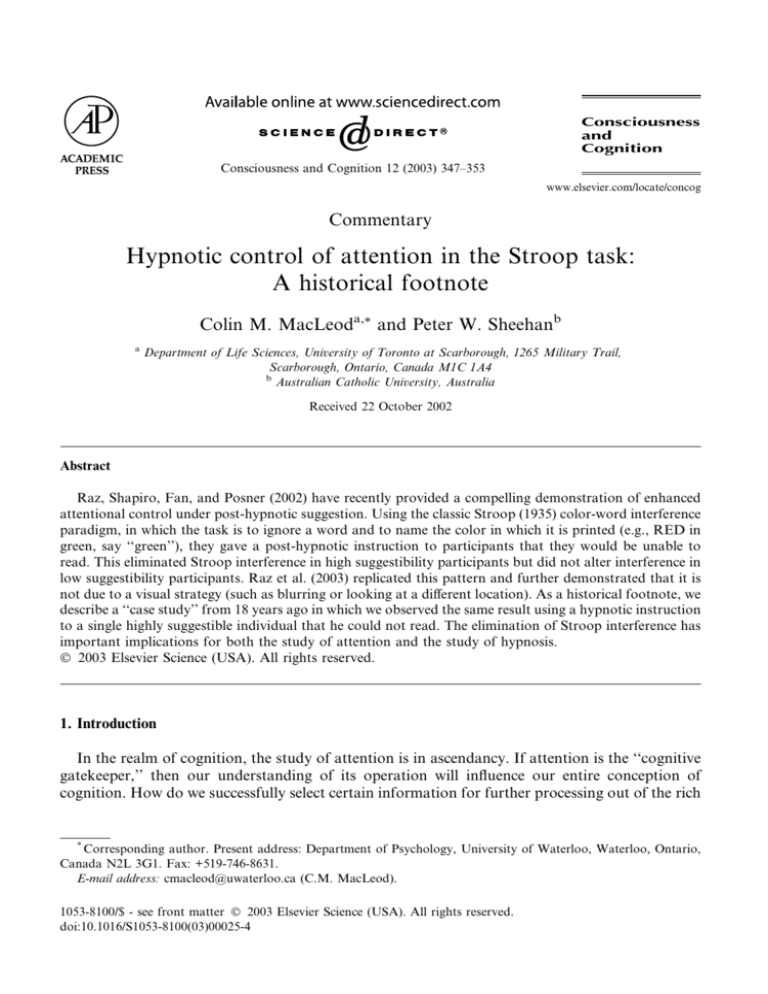
Consciousness
and
Cognition
Consciousness and Cognition 12 (2003) 347–353
www.elsevier.com/locate/concog
Commentary
Hypnotic control of attention in the Stroop task:
A historical footnote
Colin M. MacLeoda,* and Peter W. Sheehanb
a
Department of Life Sciences, University of Toronto at Scarborough, 1265 Military Trail,
Scarborough, Ontario, Canada M1C 1A4
b
Australian Catholic University, Australia
Received 22 October 2002
Abstract
Raz, Shapiro, Fan, and Posner (2002) have recently provided a compelling demonstration of enhanced
attentional control under post-hypnotic suggestion. Using the classic Stroop (1935) color-word interference
paradigm, in which the task is to ignore a word and to name the color in which it is printed (e.g., RED in
green, say ‘‘green’’), they gave a post-hypnotic instruction to participants that they would be unable to
read. This eliminated Stroop interference in high suggestibility participants but did not alter interference in
low suggestibility participants. Raz et al. (2003) replicated this pattern and further demonstrated that it is
not due to a visual strategy (such as blurring or looking at a different location). As a historical footnote, we
describe a ‘‘case study’’ from 18 years ago in which we observed the same result using a hypnotic instruction
to a single highly suggestible individual that he could not read. The elimination of Stroop interference has
important implications for both the study of attention and the study of hypnosis.
Ó 2003 Elsevier Science (USA). All rights reserved.
1. Introduction
In the realm of cognition, the study of attention is in ascendancy. If attention is the ‘‘cognitive
gatekeeper,’’ then our understanding of its operation will influence our entire conception of
cognition. How do we successfully select certain information for further processing out of the rich
*
Corresponding author. Present address: Department of Psychology, University of Waterloo, Waterloo, Ontario,
Canada N2L 3G1. Fax: +519-746-8631.
E-mail address: cmacleod@uwaterloo.ca (C.M. MacLeod).
1053-8100/$ - see front matter Ó 2003 Elsevier Science (USA). All rights reserved.
doi:10.1016/S1053-8100(03)00025-4
348
Commentary / Consciousness and Cognition 12 (2003) 347–353
flow of experience, disregarding the rest? One way to address this question is to invert it: under
what conditions do we fail to select optimally? Of all such non-optimal situations, undoubtedly
the best known is the classic Stroop effect (Stroop, 1935).
In the standard Stroop procedure, participants name the colors of printed items, saying
‘‘blue’’ to the word RED in blue (incongruent condition) and ‘‘green’’ to the non-word ‘‘xxxx’’
in green (control condition). Optimal performance would occur if the irrelevant word
dimension had no influence whatsoever on the relevant color dimension. In fact, though,
the word has a substantial effect, slowing color naming and producing Stroop interference
(incongruent–control). There is now a voluminous Stroop literature (see MacLeod, 1991;
MacLeod & MacDonald, 2000).
Stroop interference reveals the extreme difficulty of ignoring the word. Apparently, a more
practiced dimension is more automatically processed. This idea goes back to Cattell (1886), and
has been empirically confirmed (e.g., MacLeod & Dunbar, 1988) and modeled in a connectionist
framework (Cohen, Dunbar, & McClelland, 1990). When that more automatically processed
dimension must be ignored, attention is compromised: the more automatic word reading skill
cannot be ‘‘turned off’’ despite directions to attend solely to the print color (cf. Posner & Snyder,
1975). The result is a conflict between the two dimensions that is difficult to resolve, negatively
affecting color naming latency and accuracy.
Stroop interference is a large effect. When the response is oral color naming, incongruent trials
can be 100–200 ms slower than baseline. Compare this to the effect sizes of semantic priming or
negative priming, typically around 20 ms. Stroop interference is also highly robust: anyone who
can read shows a decrement in the incongruent condition. Indeed, despite the huge literature,
claims to entirely eliminate Stroop interference are rarely reported and, when they are, the studies
often have deviated significantly from the standard Stroop procedure.
2. Eliminating Stroop interference via post-hypnotic suggestion
It is intriguing, then, that Raz et al. (2002) have recently reported the complete elimination
of Stroop interference. They hypnotized individuals of high vs low suggestibility. Under
hypnosis, participants were given a post-hypnotic instruction––to be activated by a cue after
hypnosis was Ôlifted’’––that they would be unable to read and that the letters would look like
a foreign language. Low suggestibility individuals continued to show normal Stroop interference under this suggestion. But for high suggestibility individuals, Stroop interference
vanished. Raz et al. (2003) have replicated this pattern, showing that this dramatic change is
not due to a visual strategy.
The results of Raz et al. (2002, 2003) suggest a genuine ability to ignore the irrelevant
words under post-hypnotic suggestion, something that people cannot do ordinarily, even after
extensive practice and given considerable effort (MacLeod, 1998). Attention would appear to
be more adjustable under hypnosis than is normally possible, suggesting that hypnosis may be
useful for examining the limits of attentional control, as Raz and Shapiro (2002) cogently
argue. The fact that hypnosis can eliminate such a robust phenomenon is testament to its
efficacy and its cognitive relevance. Consequently, we see the results of Raz et al. as important
and compelling.
Commentary / Consciousness and Cognition 12 (2003) 347–353
349
3. A ‘‘Prequel’’
This note was prepared to complement the recent Raz et al. (2002, 2003) findings. In a discussion with the first author (CMM), Raz was intrigued to discover that we had begun a very
similar project 18 years ago. After consultation with the second author (PWS), the three of us
agreed that it would be interesting to provide an account of those early efforts. We emphasize that
this account should be seen as a historical footnote. The idea of examining the relation between
Stroop interference and hypnosis did not originate with us: Blum and Graef (1971) showed more
interference under hypnosis in high suggestibility than in low suggestibility individuals (see also
Dixon & Laurence, 1992; Dixon, Brunet, & Laurence, 1990; in contrast, see Nordby, Hugdahl,
Jasiukaitis, & Spiegel, 1999). We extended this pattern (Sheehan, Donovan, & MacLeod, 1988),
showing that, relative to the normal waking state, interference increased under hypnosis particularly for high suggestibility individuals. But these studies did not directly manipulate instructions
to participants.
The central idea of the approach taken by Raz et al. (2002, 2003) was to manipulate the instructions, telling participants that upon a cue they would be unable to read because the written
words would appear to be in a foreign language. The goal was to eliminate interference because
the now unrecognizable, unreadable words could not interfere. And this was exactly what they
observed in high suggestibility participants.
Eighteen years ago, in the academic year 1984–1985, CMM was on sabbatical at the University
of Queensland in Brisbane, Australia, where PWS was a faculty member. Having discussing our
respective interests, we decided to embark on a study of attentional control in the Stroop task
under hypnosis. The manipulation we settled on was to instruct participants under hypnosis that
they could not read. We anticipated that, if hypnosis was a sufficiently powerful controller of
attention, then interference should be reduced or perhaps even eliminated.
The account that follows has been assembled from notes and files constructed at the time of our
collaboration, together with our recollections. The primary sources are (1) the script of a research
talk given by CMM in the ‘‘Ebbinghaus Empire’’ at the University of Toronto on September 18,
1985, just after the sabbatical, (2) printouts of data files from the single individual tested on
February 19, 1985, and (3) procedural details which were similar to those reported by Sheehan
et al. (1988).
The talk script identifies the motivating question as ‘‘are there any factors that can reduce or
eliminate Stroop interference?’’ ‘‘After considerable discussion, we settled on the instruction to be
unable to read, and to use the Kahneman and Chajczyk (1983) version of the Stroop task with
color bar above color word. We considered a negative visual hallucination instruction (cannot see
the word), but thought the reading instruction more suitable. We also decided to do the study with
both the Kahneman and Chajczyk and the Stroop versions of the task.’’ This distinction refers to
the separated vs integrated versions of the task (see MacLeod, 1998). We began with the separated
version, which typically shows smaller interference, to give our initial attempt the best chance of
succeeding. We would then ‘‘plan to run three groups on each version of the task: (1) high susceptible, (2) normal, and (3) simulator.’’
As it happened, the planned study was never carried out, despite efforts on both our parts over
the ensuing years. In fact, though, one participant was tested, with promising results. Our eagerness to test more participants was stymied by an unfortunate event: Queensland power workers
350
Commentary / Consciousness and Cognition 12 (2003) 347–353
staged a strike, leaving the entire state––and our computers––without electricity for two weeks, by
unhappy coincidence CMMÕs last two weeks in Queensland.
4. Method
4.1. Participant
The participant was a ‘‘somnambulist’’ (highly hypnotizable) individual known to PWS from
prior studies. Born in Germany, this individual switched from English to German when, in the
preliminary phase, PWS age regressed him earlier than about age 10. He sat with PWS and CMM
in a dimly lit room in a comfortable chair.
4.2. Materials and apparatus
The experiment was carried out on a BBC microcomputer with a color monitor, programmed
in BASIC with timing routines permitting 1 ms resolution from responses into an interfaced
microphone. The print colors and words were RED, BLUE, GREEN, and YELLOW; the control
string was XXX.
4.3. Procedure
The design of the experiment was to involve six blocks of Stroop trials: ‘‘(1) practice/baseline,
(2) baseline, (3) task motivated (i.e., hypnotic instructions without induction), (4) baseline, (5)
hypnotized, and (6) baseline.’’ The goal was ‘‘collecting lots of baseline data around key blocks (to
watch for practice effects, etc.).’’ The notes also indicate that ‘‘we lost the last block due to a
power failure.’’
To describe block configuration, ‘‘Each block was made up of 96 trials, 32 per condition . . . conditions were randomized.’’ The three conditions were congruent (e.g., RED in red, say
‘‘red’’), incongruent (e.g., BLUE in red, say ‘‘red’’), and control (e.g., XXX in red, say ‘‘red’’). The
congruent condition was included because one possible strategy for eliminating Stroop interference in a study using only incongruent and control trials would be to selectively slow down in the
control condition. The congruent condition would reveal such a strategy because abnormally
large facilitation would result.
Details about precise trial timing no longer exist, but there was a brief blank screen (less than a
second) between trials, and the color bar plus word stimulus remained on the screen until the
participant responded into the microphone. The color bar was about the same height as the word
was presented above the word (printed in white) at the center of the screen.
5. Results
Table 1 presents medians, not means, for each condition because there was only one participant. However, the means showed a very similar picture. Recall that our task was the separated
Commentary / Consciousness and Cognition 12 (2003) 347–353
351
Table 1
Median response times in milliseconds and proportions of errors (in parentheses) as a function of experimental block
Block
Condition
Congruent
Incongruent
Control
Facilitation
Interference
Practice 1
576
(.000)
528
(.062)
628
(.031)
512
(.031)
638
(.000)
722
(.156)
599
(.031)
739
(.062)
602
(.062)
651
(.075)
612
(.000)
521
(.031)
702
(.094)
509
(.031)
653
(.111)
36
110
)7
78
74
37
)3
93
15
)2
Practice 2
Instructions only
Practice 3
Hypnosis + instructions
Difference scores
version with vocal responding. Relative to the integrated version with button press responding
used by Raz et al. (2002, 2003), ours should produce similar effects, with interference increased by
switching to vocal responding but decreased by switching to the separated version.
Consider the three baseline blocks. The derived scores of facilitation (control–congruent) and
interference (incongruent–control) decreased between the first and second practice blocks and
then roughly stabilized (compare Practice 2 to Practice 3). This pattern is typical of such data; in
particular, facilitation usually is less reliable than interference and sometimes is not significant (see
MacLeod, 1991, 1998). In the third block, when given just the instructions about being unable to
read but without hypnotic induction, the participant appears to have tried to adjust his strategy,
principally by slowing down his control condition. This resulted in reduced interference but increased facilitation. The total congruency effect of 111 ms remained, however, like those in the
surrounding two practice blocks (71, 90 ms), and was certainly not smaller.
The impressive result is evident in the hypnosis plus instruction block. Here, interference
vanished, and facilitation was minimal.1 Had the participant attempted to use a strategy similar to
that used in the instructions-only block, he would have displayed decreased interference but increased facilitation. Instead, both difference scores fell close to zero.
6. Discussion
Raz et al. (2002, 2003) have reported two compelling data sets showing that a post-hypnotic
instruction to be unable to read can eliminate Stroop interference in high suggestibility participants, using the integrated, button pressing task version. Our results suggest that the same pattern
occurs for an instruction given during hypnosis, using the separated, vocal task version. Of course,
1
A peculiar change occurred in the hypnosis plus instruction block: the participant named all instances of yellow as
‘‘green,’’ despite not having had any apparent difficulty discriminating the colors yellow and green prior to this block.
We have, therefore, considered all trials where the color yellow was responded to as ‘‘green’’ to be correct responses,
adjusting the condition assignment accordingly. Removing the yellow trials results in a very similar pattern.
352
Commentary / Consciousness and Cognition 12 (2003) 347–353
the usual cautions about single-case studies apply to our study. But our results do suggest that
generalizing the Raz et al. studies would be worthwhile, as they no doubt will do.
What is striking about their results is the complete elimination of Stroop interference, a finding
rarely reported using the standard version of the task (but see Melara & Algom, 2003). One
implication is that hypnosis is a very effective way to control attention, given its dramatic impact
on such an ordinarily robust effect. Eighteen years ago, we considered several other questions
worth pursuing, including instructing participants (1) that they could read the words RED and
BLUE but not the words GREEN and YELLOW, such that interference should be present only
for the former set, or (2) that each of the print colors would appear to be another color (e.g., red
would appear blue, green would appear yellow) such that the congruency of the conditions would
be redefined. The elegant work of Raz and his colleagues opens up these and many more possibilities, and we look forward to new developments in their impressive program.
Acknowledgments
The research reported here, and the sabbatical leave that permitted it, were supported by a
Discovery Grant (A7459) and a travel grant from the Natural Sciences and Engineering Research
Council of Canada. We greatly appreciate the collegiality and encouragement of Amir Raz in the
preparation of this brief historical note, which also benefited from the comments of Daniel Algom
and two anonymous reviewers.
References
Blum, G. S., & Graef, J. R. (1971). The detection over time of subjects simulating hypnosis. International Journal of
Clinical and Experimental Hypnosis, 19, 211–224.
Cattell, J. M. (1886). The time it takes to see and name objects. Mind, 11, 63–65.
Cohen, J. D., Dunbar, K., & McClelland, J. L. (1990). On the control of automatic processes: A parallel distributed
processing account of the Stroop effect. Psychological Review, 97, 332–361.
Dixon, M., & Laurence, J.-R. (1992). Hypnotic susceptibility and verbal automaticity: Automatic and strategic
processing differences in the Stroop color-naming task. Journal of Abnormal Psychology, 101, 344–347.
Dixon, M., Brunet, A., & Laurence, J.-R. (1990). Hypnotizability and automaticity: Toward a parallel distributed
processing model of hypnotic responding. Journal of Abnormal Psychology, 99, 336–343.
Kahneman, D., & Chajczyk, D. (1983). Tests of the automaticity of reading: Dilution of Stroop effects by colorirrelevant stimuli. Journal of Experimental Psychology: Human Perception and Performance, 9, 497–509.
MacLeod, C. M. (1991). Half a century of research on the Stroop effect: An integrative review. Psychological Bulletin,
109, 163–203.
MacLeod, C. M. (1998). Training on integrated versus separated Stroop tasks: The progression of interference and
facilitation. Memory & Cognition, 26, 201–211.
MacLeod, C. M., & Dunbar, K. (1988). Training and Stroop-like interference: Evidence for a continuum of
automaticity. Journal of Experimental Psychology: Learning, Memory, and Cognition, 14, 126–135.
MacLeod, C. M., & MacDonald, P. A. (2000). Inter-dimensional interference in the Stroop effect: Uncovering the
cognitive and neural anatomy of attention. Trends in Cognitive Sciences, 4, 383–391.
Melara, R. D., & Algom, D. (2003). Driven by information: A tectonic theory of Stroop effects. Psychological Review.
Nordby, H., Hugdahl, K., Jasiukaitis, P., & Spiegel, D. (1999). Effects of hypnotisability on performance of a Stroop
task and event related potentials. Perceptual and Motor Skills, 88, 819–830.
Commentary / Consciousness and Cognition 12 (2003) 347–353
353
Posner, M. I., & Snyder, C. R. R. (1975). Attention and cognitive control. In R. L. Solso (Ed.), Information processing
and cognition: The Loyola symposium (pp. 55–85). Hillsdale, NJ: Erlbaum.
Raz, A., Landzberg, K. S., Schweizer, H. R., Zephrani, Z., Shapiro, T., Fan, J., & Posner, M. I. (2003). Posthypnotic
suggestion and the modulation of Stroop interference under psychoplegia. Consciousness and Cognition.
Raz, A., & Shapiro, T. (2002). Hypnosis and neuroscience: A cross talk between clinical and cognitive research.
Archives of General Psychiatry, 59, 85–90.
Raz, A., Shapiro, T., Fan, J., & Posner, M. I. (2002). Hypnotic suggestion and the modulation of Stroop interference.
Archives of General Psychiatry, 59, 1155–1161.
Sheehan, P. W., Donovan, P., & MacLeod, C. M. (1988). Strategy manipulation and the Stroop effect in hypnosis.
Journal of Abnormal Psychology, 97, 455–460.
Stroop, J. R. (1935). Studies of interference in serial verbal reactions. Journal of Experimental Psychology, 12, 242–248.

